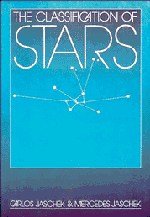3 - Spectral classification systems
Published online by Cambridge University Press: 04 April 2011
Summary
Spectral classification started in the second half of the nineteenth century and has had a long and interesting development, which is detailed by Curtiss (1932), Fehrenbach (1958) and Seitter (1968). Instead of following the historical developments in their complicated interactions, we shall study in detail only two classification systems, because they synthetize the developments. These two systems are the Harvard and Yerkes systems. In the last section of this chapter we shall consider briefly classifications at higher plate factors.
The Harvard system
The material for this system consists of objective prism spectra of a large number of stars. Regrettably not all spectra were obtained with the same cameras and/or objective prisms, and this produced some undesirable consequences. In particular, brighter stars were observed with lower plate factors than fainter ones, the latter having a total length of 2.2 mm between Hβ and Hε. For stars of intermediate brightness this length was 5.6 mm and for the brightest stars up to 80 mm. However, all spectra were widened considerably to more than 2 mm.
The Harvard scheme divided the spectra into classes symbolized by capital letters, arranged in alphabetic order. Class A was described as ‘only the hydrogen series and generally K are visible’. In class B the lines of class A were supplemented with λ4026 and λ4471 of He i. Class C was the class of stars of types A and B but with Hδ and Hγ observed as double lines.
- Type
- Chapter
- Information
- The Classification of Stars , pp. 31 - 47Publisher: Cambridge University PressPrint publication year: 1987



